Story and photos – Rebecca Ashton
Why is German dressage so good? Basics.…you’ve heard it all before. What you see when you watch the best-of-the-best train is basics. This attention to detail and self discipline is just so perfectly tuned. This is what we saw at Dorothee Schneider’s masterclass at Willinga Park. Every combination received the same message from the German Olympic gold medalist – straighten the horse, keep the outside rein, not so much inside rein, create the rhythm with your hips, keep him straight. Correct dressage – the skill is maintaining it at all times.
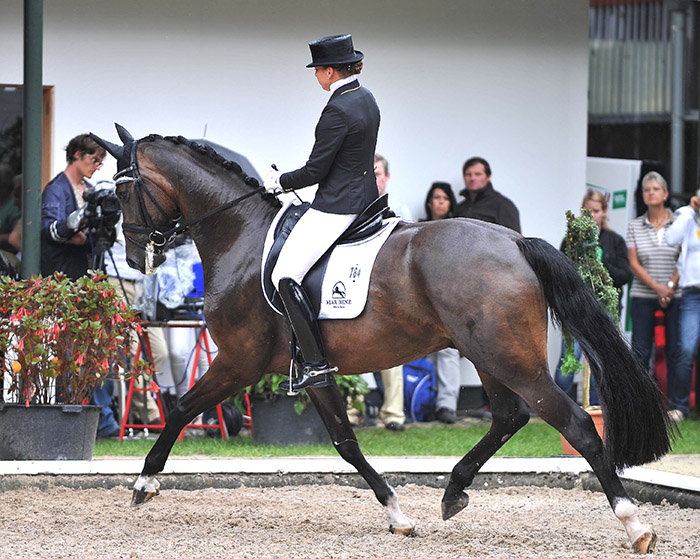
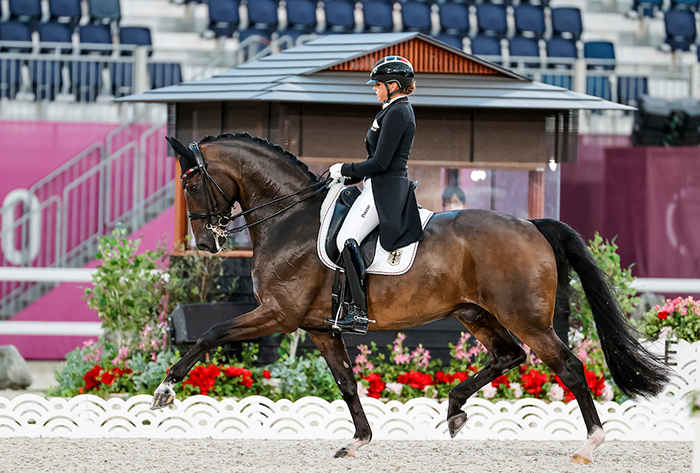
Dorothee and one of her many stars, as a Bundeschamps winning young horse, and Olympic medal winner, Showtime
Dorothee told us, “I want to show you my concept of developing horses. I look for a combination of good suppleness and I need to be able to straighten the horse. The first step is to stretch the horses forward and down, but not just with the rein. I need to have a straight horse stepping the hind legs forward to the rein. It can only go to the contact if it’s balanced behind me.”
“The next step is the motivation. The horse should have the opportunity to go into the paddock. The possibility to chill and move as they want, then they can concentrate when you work them. The rider has to be sensitive to feel any problems in the horse – the contact between the rider and the horse is important. When the horse does something well, pat it so the next day gets better and better. You have to mentally have them on your side. This all begins with the basics. Then the horse can use its own body and balance the movements and then you can develop into riding a good shoulder in, then half pass with good balance and contact.”
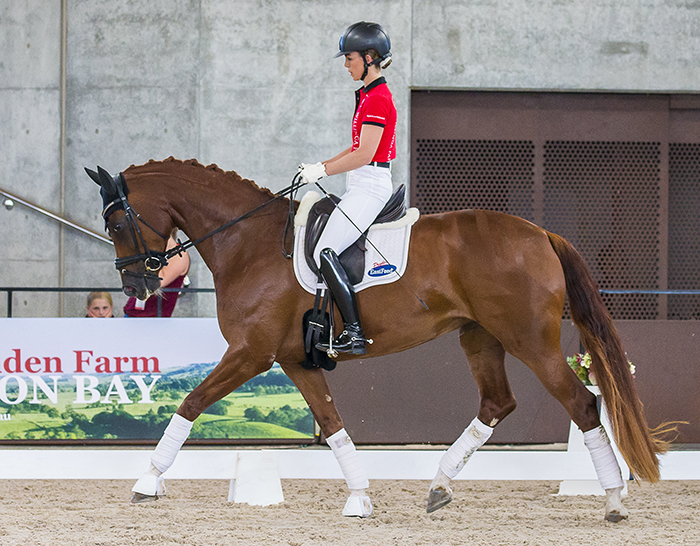
Robbie and Fleur de Lys
The first two riders into the Willinga Park indoor were Robbie McKinnon on Hollands Bend Fleur de Lys and Lewis Newton on a very spooky Keep Sake, both four-year-olds. 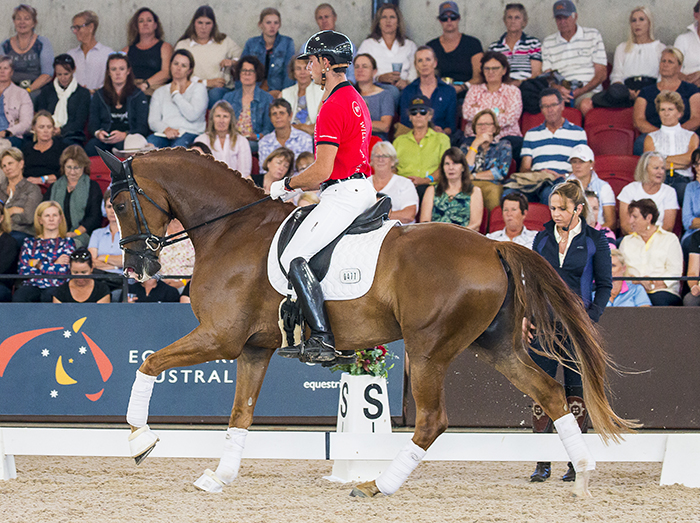
Lewis and Keep Sake
Dorothee set the template for what would be every session. “Let them have a look, and get familiar with the arena – Lewis, Give him a pat. Give him confidence. Maybe ride behind Robbie.”
story continues below advertisement
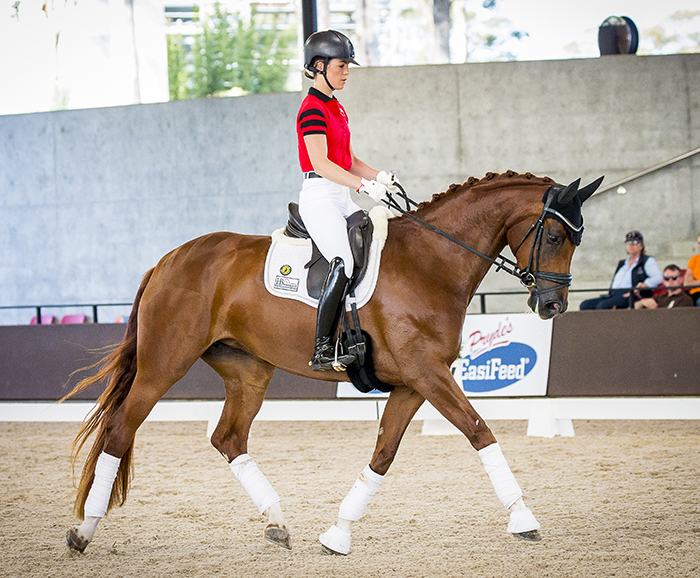
“We start with rising trot. It’s very important to warm the horse up and stretch it from the hind leg to both hands. Then the rider needs to be sensitive to find the right rhythm for that particular horse. If it’s too slow, he can’t take the hind leg over the back to the mouth. If it’s too fast, there’s no swing.”
“Don’t pull your hands across the horse’s neck, give the horse the opportunity to find the contact in both reins. Also ride on the second track and the quarter line to feel better the balance. The horse has one hollow side and one crooked side, you have to fix this. Robbie’s horse is hollow to the left so we have to get the left hind leg under, and the right shoulder out a bit more. When you rise, take the hind leg with you. We have to manage the inside leg, and the outside rein. We try to help young horses to find the line, straight or bent, but with the contact on the outside rein.” 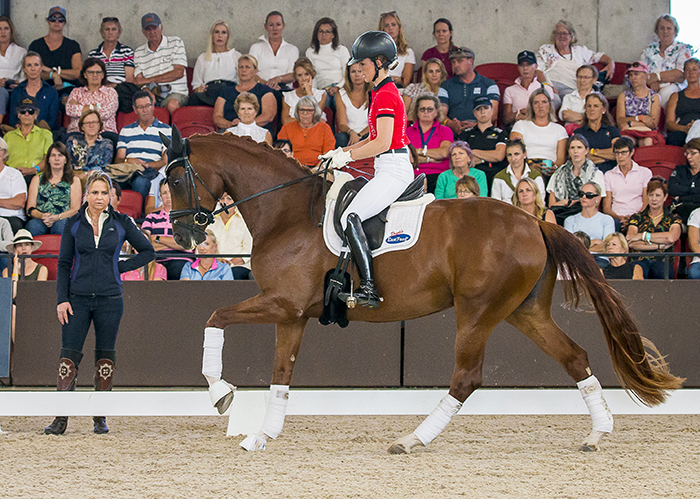
Then there was a little bit of canter, “Prepare with the inside leg and the outside leg is going back. Just flexion on the inside. You transport the power from the hind leg over the back into both reins. Do a canter to trot transition. My choice at this age is to do it on a bent line.”
“The rider swings both hips to both hands, open knee, long leg. Keep the contact with the outside rein. Open the poll a little. Very good. Pat, and take a short break.” 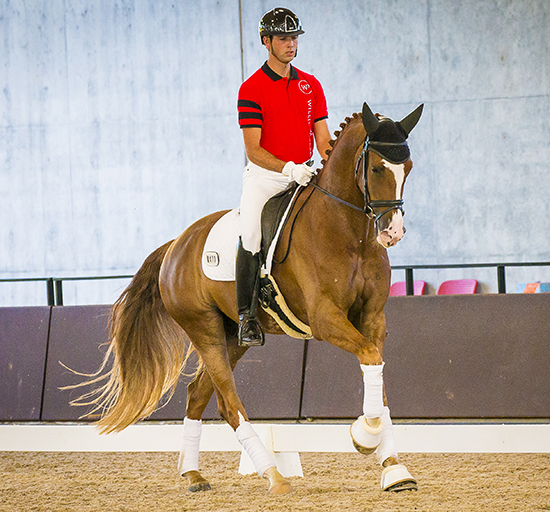
Then Lewis began with his spooky chestnut. Again Dorothee encouraged getting the rhythm from the hind leg to the bit and what would become common thought the evening, keeping the riders off the track and making more use of the second track and quarter line.
“Look at the ears that he’s straight in front of you. Really work on getting that outside rein contact and getting the inside hind leg to go on the line off the inside leg. Try to take the hind leg with you when you rise to get a little bit more swing.”
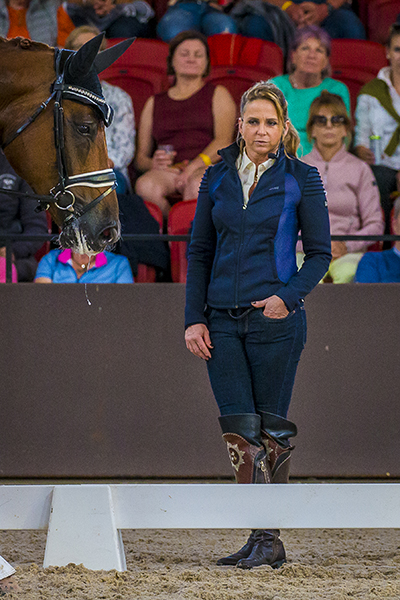
“Balance, rhythm. straightness. Stabilise the hind leg under the body. They are the points of the four-year-olds. Make the strides with your sitting in the canter. Show the horse by riding forward. Think a little bit about shoulder in on the circle line. Canter to trot, ride the rhythm in the transition to help him.”
“Then think just a little shoulder in the rising trot because he’s a little bit tense. Try to stretch him just a little bit downwards. It’s not so easy to manage a tense horse. Give him a pat. Take the rein a little wider to show him the way to stretch, but always with contact. Not without contact. Always the positive contact.”
Robbie was back and it was more transitions in sitting trot once the rhythm was good in the rising trot. “Good, you have the neck between both reins. Play a little bit with the wrist to move the mouth gently if you feel the horse pull against your hand. Now on a bent line, flex the poll in front of you in a small way to the inside. Then ride a walk trot transition on the bent line. Then onto the other rein which is her hollow rein, so drive her inside hind leg forward with your inside leg, and with your sitting. Go into rising trot if she comes behind you, when she does that she goes into the canter, so the rising trot just stabilises things again.”
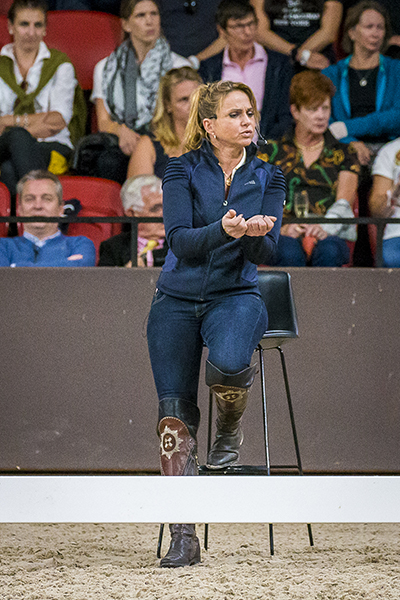 No canter until the trot was in front of the leg. It was about setting the next stage up for success, rather than hoping it worked:
No canter until the trot was in front of the leg. It was about setting the next stage up for success, rather than hoping it worked:
“Directly forward on the bent line. Ride with your hips to both reins. Then the long side and before the short side, stabilise the line to the short side. Keep that rhythm. Think a light shoulder in to drive the inside hind leg to the outside rein. Then a canter trot transition from the hind leg.”
A small shoulder in was to used improve the flexion on the right and Dorothee emphasised turning the outside shoulder in front of the inside hind leg.
The work was interspersed with stretchy rising trot, but even then the horse had to be good in the contact and in front of the leg.
Lewis was back trotting and it was the same attention to detail; “Stretch your body. The right hind leg swings away to the right (not under) so correct it. Walk trot transitions, then canter transitions. Start the transitions in the hind leg. Not too much flexion. Outside rein down. If he trots too fast, he doesn’t listen to you. You feel he’s looking a little bit, so help a little bit with your seat. Make the rhythm with your seat. Then stretch him keeping the connection with both reins. Too much flexion in the neck means you don’t have control of both shoulders. You need both shoulders in the turn, which is why you don’t want to use too much inside rein”
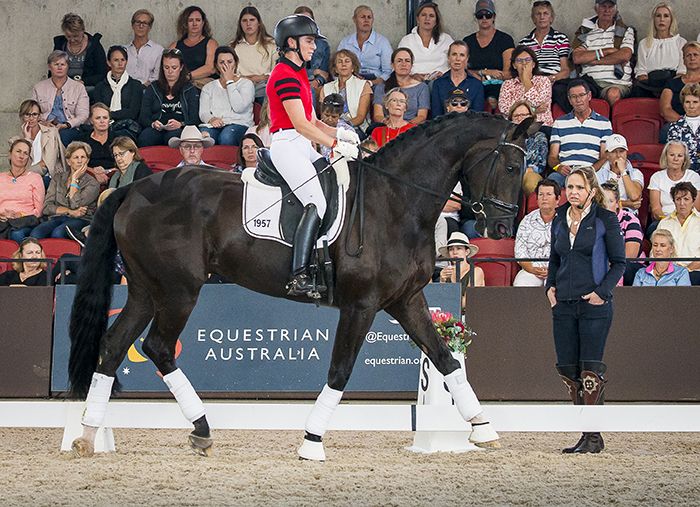
Edwina and Sachio
Session two saw Edwina Hutton-Potts on the six-year-old WPH Sachio. Although the horse was training half passes and flying changes, Dorothee continued to emphasise the importance of straightness and suppleness.
“Feel the rhythm from the hind leg, which rhythm is good for him? Check the control of the outside rein. Show him he is able to stretch. Have contact on both reins. Then canter/trot transition. I think the canter trot transition gives us a good picture into the back of the horse. Ride the rhythm to the bit. Make the rhythm with the hips. You want the hind leg to both reins.”
“Feel the hind leg work under the horse. Keep the hands down in front of the saddle. As you turn, take the outside shoulder with you. Help him. When he wants to come behind you, ride your hips to both reins. When you feel him swinging away with the shoulder on the circle, keep his outside ear in front of his outside shoulder.”
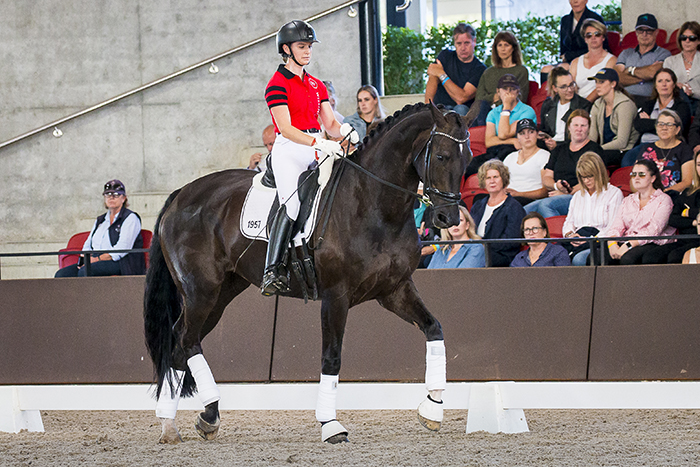 Dorothee continually went to shoulder in to manage the horse’s hind leg and keep it stepping under the body to improve the balance. Edwina went on with half pass from the track to the centreline before circling to stabilise the bending then transitions to stabilise the balance and improve suppleness.’
Dorothee continually went to shoulder in to manage the horse’s hind leg and keep it stepping under the body to improve the balance. Edwina went on with half pass from the track to the centreline before circling to stabilise the bending then transitions to stabilise the balance and improve suppleness.’
The break still required attention from the rider, “Even at the walk, get him to step up to the bit. The walk is hard to ride because there’s no swing. The walk is very important because in the tests they are times two. You have to get the rhythm and give them the neck so they can find the contact. When he drops the contact, use one rein to get him up and give him a little kick from behind then give him a pat.” The horse had to keep search for the bit.
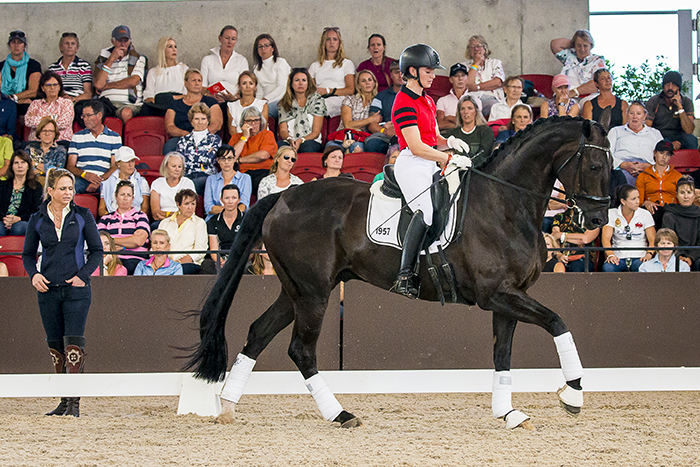 The canter work saw Dorothee remind Edwina of those important basics before she began; stabilise the outside shoulder and have the inside hind leg under the body. Concentrating on where the shoulders are placed rather than bending the neck too much.
The canter work saw Dorothee remind Edwina of those important basics before she began; stabilise the outside shoulder and have the inside hind leg under the body. Concentrating on where the shoulders are placed rather than bending the neck too much.
“Take the big stride with you into collection. You have to manage it with the hips. Counter canter, the shoulder has to stay on the line and not too much to the outside. Then trot and directly a small circle to establish the new bend. Then canter shoulder in down the long side but off the track. Collect before the walk transition but bend him and ride him to the bit first. Close him behind you so he can get longer in front of you.”
Even when going back up from walk to canter, shoulder in first was used so Edwina could take this bend and flexion into the canter and up the long side.
The exercise then progressed to half pass at canter up the centre line before turning onto the track in counter canter with a flying change off the long side, always with the feeling that the rider was finding the rhythm in the hips.
When the horse was a little strong, shoulder in was used, and then trot/walk transitions in shoulder in to keep the softness, always keeping the rhythm and keeping the horse in front of the rider.
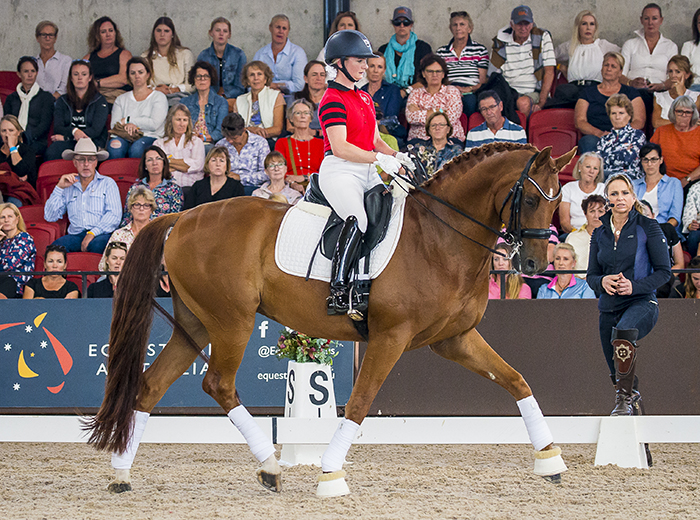
Alice and Berlin
Bluefields Berlin and Alice Hurley were next and Dorothee wanted to focus on improving the contact of the nine-year-old chestnut. “He’s not every time in front of her and sometimes playing with the tongue. So we start with one or two rounds rising trot then one or two rounds canter. When you feel he’s behind the bit, give him a little motivation with the leg. Take him with you when you rise. Open the poll. Very good. Try to have the hind leg under the body, then you turn the shoulder. Not so much flexion to the inside. Have the contact with both reins. Stay on the second track.
“Open you knee and have a long leg so you can use your hip a little more. Play a little with the inside rein, but keep contact on the outside rein. The warm up time is very important for the horse; stretch, improve the contact, hind leg working over the back on both reins, then you take all this into bending, flexing and sideways. Keep the horse in both reins not crossing the neck with your hand.
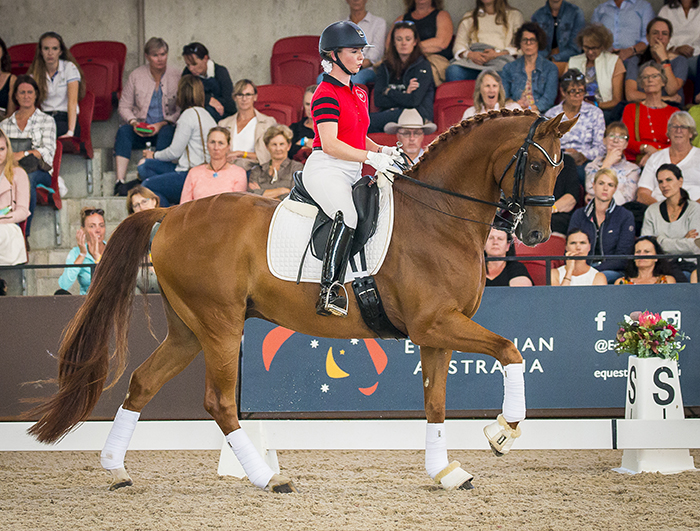
“In the canter, the inside hind leg needs to be a little more under the body. Ride your hip to the outside rein; make the rhythm with the hip and swing the power of the hind leg through his body with your hips. Help the horse into the transition. Transitions are very important to me.”
The straight lines interspersed with bent lines and riding on the track was changed to riding off the track, all the time taking the good, correct work into the next phase. “Try to work his inside hind leg under the body a bit more because it’s working against your bend a bit so think of a light shoulder in. Play with your wrist on the bit to get the tongue down again. If the horse comes behind you and he waits and waits, you have to improve what’s going on behind to get the good transition.” Dorothee again highlighted the focus being on riding the outside shoulder in front of the inside hind leg in the shoulder in. When things got a little fragile, it was back to a circle to reestablish the bend.
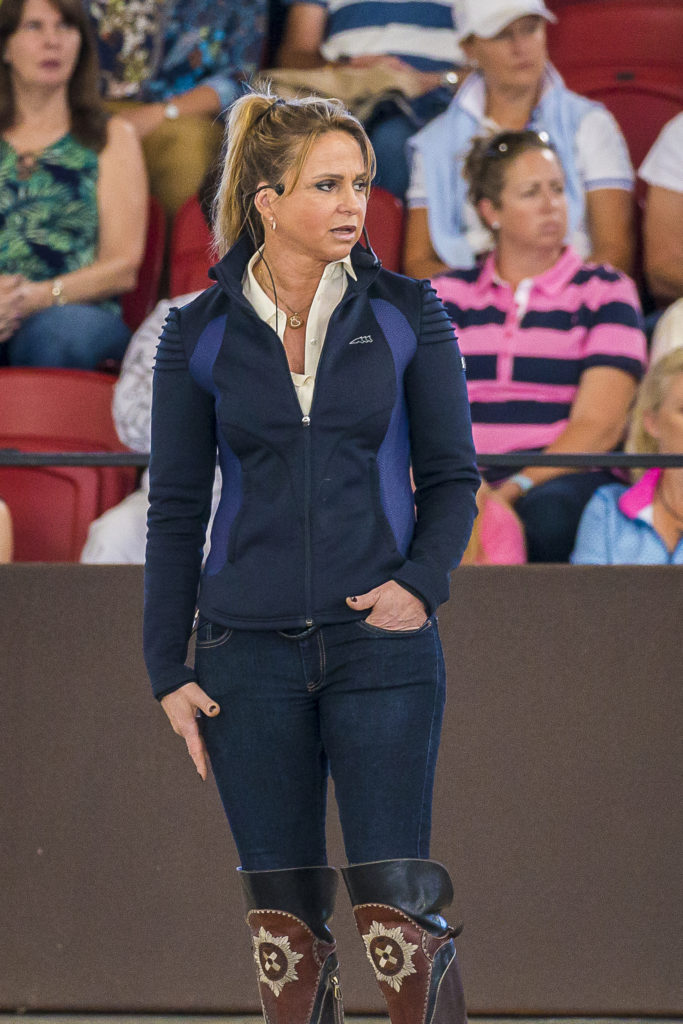 Dorothee then wanted to see forward and back in the canter, both on the straight line and bent line whilst thinking shoulder in. Still Alice was encouraged to keep riding the horse to the bit to get him over his back and active into both reins, resisting the temptation to over work the inside rein. This idea of not over flexing to the inside was also used to help the flying changes.
Dorothee then wanted to see forward and back in the canter, both on the straight line and bent line whilst thinking shoulder in. Still Alice was encouraged to keep riding the horse to the bit to get him over his back and active into both reins, resisting the temptation to over work the inside rein. This idea of not over flexing to the inside was also used to help the flying changes.
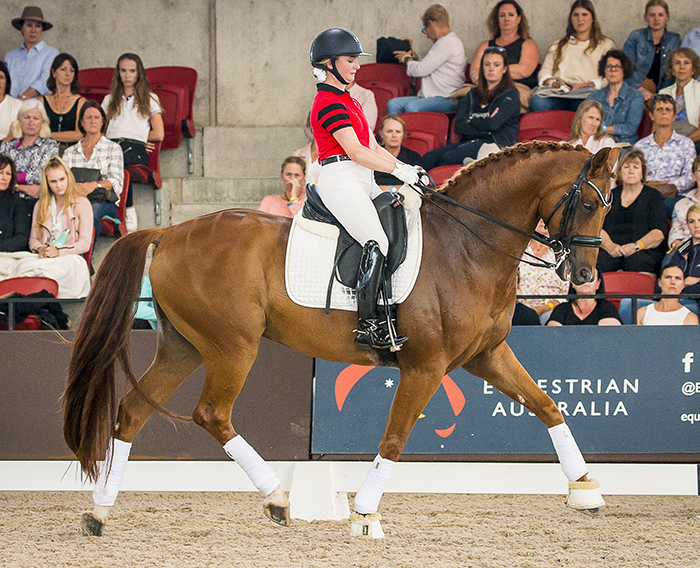 Dorothee offered another exercise to help the horse even more, “Ride a small circle changing between shoulder in and travers. Help him find his way to the bit. It’s better when he’s going in front of you. Sit him on the outside hind leg and turn the shoulder around it. Make the outside hind leg active with your hip. That’s better, ride him out and give him a pat for that. Activate the hind leg and ride it to the bit. That’s our goal.” And this was expected even during the walk break.
Dorothee offered another exercise to help the horse even more, “Ride a small circle changing between shoulder in and travers. Help him find his way to the bit. It’s better when he’s going in front of you. Sit him on the outside hind leg and turn the shoulder around it. Make the outside hind leg active with your hip. That’s better, ride him out and give him a pat for that. Activate the hind leg and ride it to the bit. That’s our goal.” And this was expected even during the walk break.
Alice and Berlin finished the session with two flying changes on each long side, keeping the horse sitting behind to allow him to reach up in front. “The mouth gets better and better. When you activate the hind leg and you have him between two reins and you have the power coming through his body form behind, then the contact is good. The rest is not a problem for him.” 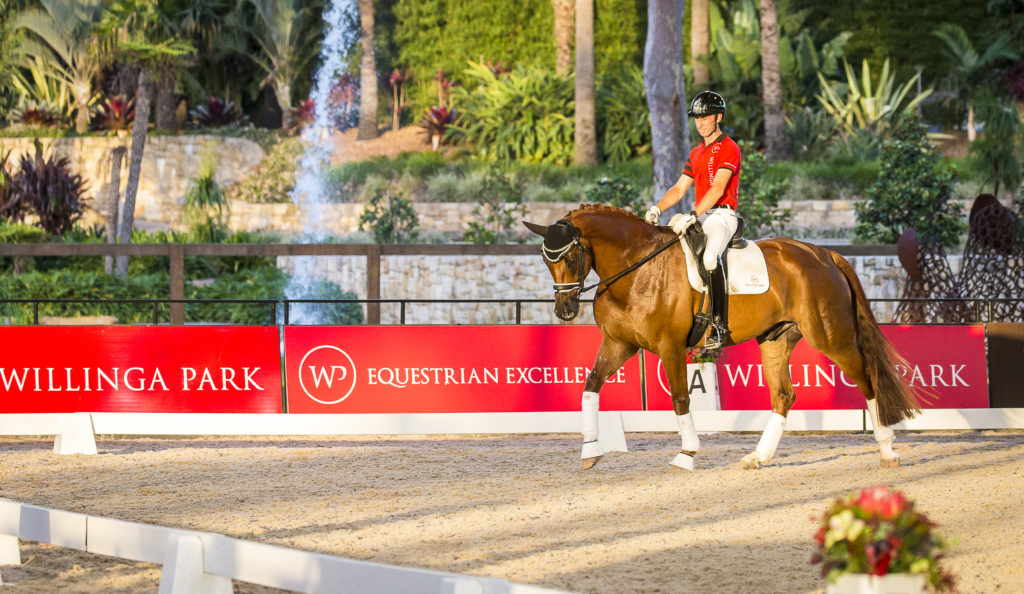
Jayden and Quincy B
Jayden Brown and the 6 year old Quincy B were first in after interval. The message was the same, “Forward in the canter from the hip. Not too much flexion. Stabilise the rhythm in the trot in between the canters. Make him a little bit longer in the poll and the neck. Activate the hind leg.” There’s just no getting away from those basic essentials! 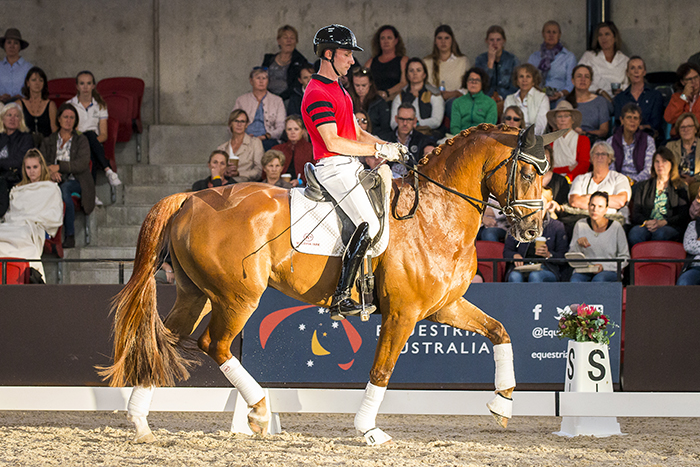
Dorothee then wanted some working trot to get more activity in the horse and once again she stressed the importance of transitions and the feeling of straightness into both reins. She wanted the poll a little more open so encouraged Jayden to activate the hind leg and even ride some smaller steps in rhythm and always encouraging Jayden to give the horse confidence before playing with some half passes. “Take your outside hand a little bit to the outside so you get a better contact on the outside. Then use your inside leg. With a young horse I would ride shoulder in in between the half pass or change rein after the half pass to get new bend and flexion. Very good swing the hind leg to the mouth in the trot!”
In the walk, Dorothee wanted to look at some pirouettes so helped prepare Jayden, “Ride your line and every time take his outside shoulder with you. Then shoulder in on the circle then walk pirouette. Just turn the shoulder around the hind leg. Make the neck and poll longer. It is very important to have the horse prepared with the bending, contact, rhythm before the pirouette. Let him use his neck in the walk to find his balance.” 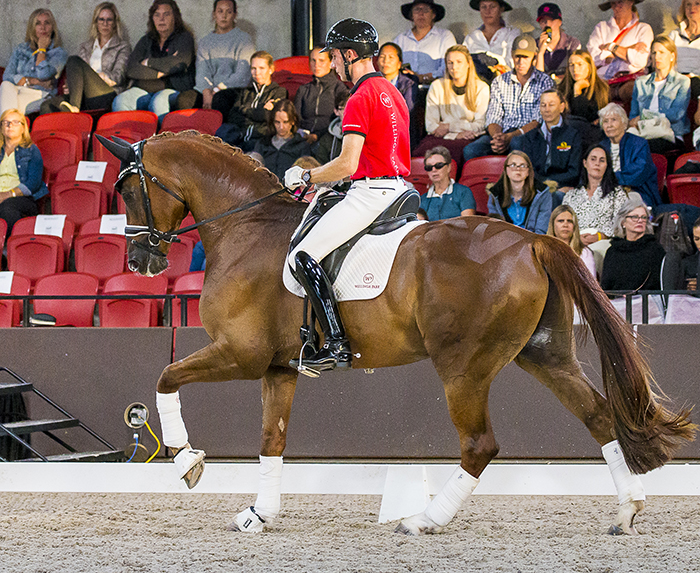
Transitions were never too far away and so canter walk transitions were the focus always with some forward and back in the canter from the rider’s hip before the next walk transition to encourage a good, active rhythm. It was important for Jayden to have good control of the horse’s shoulder before the canter strike off once more.
The work progressed to canter shoulder in then half pass to the track from the centre line, straight in counter canter around to the next long side then flying change. Dorothee was impressed with how safe the half passes and changes were for a six year old so tentatively chose to look at the collected canter before the end of the session, “He’s very young so we must be careful, but he has some power, so I think we can try it. 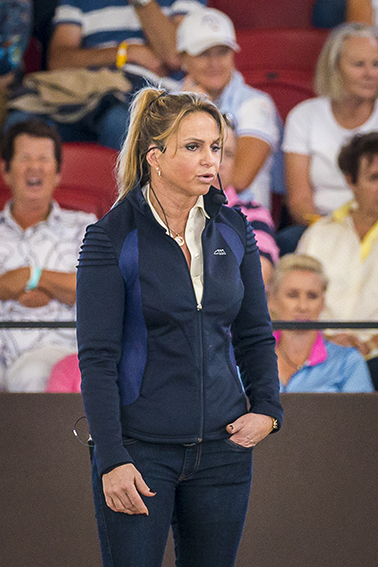
“Canter circle and make the circle a little bit smaller. Try travers canter but only turn enough that he can still stay in front of your leg. Very good. He’s very talented in collection in canter. It’s amazing that he collects like this at this age,” but Dorothee warned, “Look to make not too much with him!”
Before they finished, Jayden and Quincy revisited the trot and stretchy trot, with transitions within the stride making sure that the hind leg was active enough and that there was still good connection to the outside rein to keep control of the shoulder.
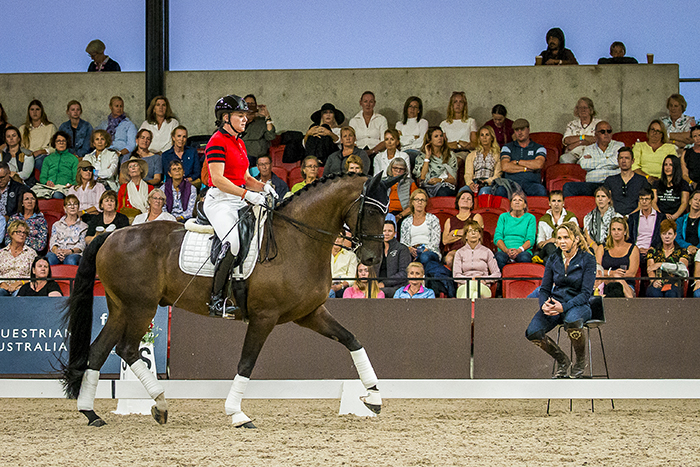
Jenny and Senator
The final combination was Jenny Gehrke and the nine-year-old Senator who competes at Inter A/B, so considered a young Grand Prix horse. The start of the session was the same as the baby horses before him. “Even the upcoming Grand Prix horse we ride first a bigger stride. Get him forward in front of your hips. A little bit forward and back on straight lines then onto the bent line and rising trot keeping the inside leg riding to the outside rein and have him stretch to the snaffle. Then canter. Try to move his mouth a little bit with your wrist. Soft mouth. Stretch your body and take your shoulder back. Move forward with your hip to help him with the three beat rhythm in the canter. Keep his inside leg stepping under the body.” If the bend of the horse was compromised, it was back to a 20 metre circle.
Next were trot shoulder ins to really improve the inside of the horse before shoulder in to half pass. It was the same progression as Jayden and Quincy. Jenny was encouraged to get more uphill balance and swing from the horse using her hips. Now Dorothee wanted a change of rein between the half passes to make sure that the inside leg and outside rein were always changing and that either side was always accessible. “Don’t let him ride down onto his front leg. Not deeper, have him in front of you. Only the outside shoulder in front of the inside hind leg. Look to the point and swing him there. Takt takt, activate the hind leg when you bring him back to you. Even across the diagonal, forward and back and keep playing with the balance. A little bit faster with your wrist. You need the contact but not too much pressure, but he closed very well with the hind leg.”
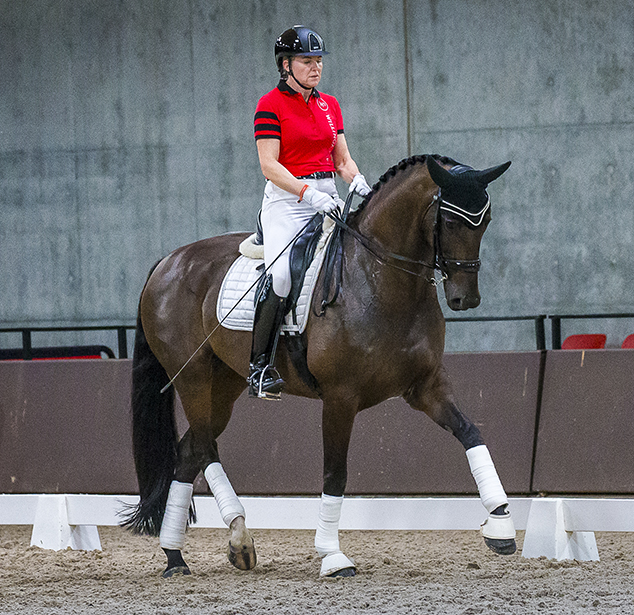
After a break, the work continued as the horses before; canter shoulder in, half pass, counter canter, flying change, every once in a while rebalancing and rechecking on a circle and in shoulder in. Dorothee explained the importance of shoulder control, especially when it came to riding the canter zig zag, so it was important for the combination to really get that feeling now.
The working pirouettes were next and still Dorothee encouraged Jenny to ride the horse more uphill to both reins, supporting with the outside leg and rein as she rode into them and balancing with her inside leg as she rode out of them with some forward and back strides in between the pirouettes to keep the quality of the canter.
The next movement to look at was the two tempi changes, first on the quarter line. “They can only be as good as the canter is, so improve the canter first. Have him in front of you.” Between each quarter line was a chance for the rider to either rebalance the horse on a circle or go into medium canter to activate the hind legs before playing with a few one tempis. Dorothee didn’t mind how many, as long as the horse was balanced and straight. These were then taken onto the diagonal. Can you see how each exercise was made slightly more challenging but in between the horse was taken back to a circle or shoulder in to balance, bend and activate the hind leg?
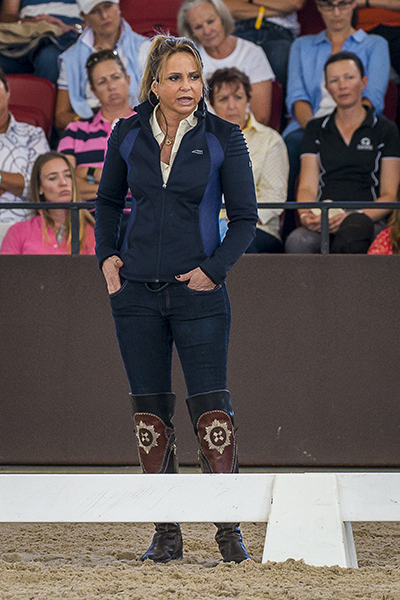
After a break, the session finished with a little bit of passage and piaffe. “Stay on the second track so you can have a feeling for the balance. Activate the hind leg first.” Everything always had to start with the hind leg and after the very collected work, the horse still had to be able to lengthen the neck and open the poll a little to stretch afterwards.
Really the work for each horse was exactly the same, with the older horses just showing more advanced movements. In some ways I could have written my account with a quarter of the word count, but I think it’s important to understand how those simple things were repeated and repeated with every rider. And although Dorothee stressed that every horse is individual and must be treated as such, there are those stalwart checks that must always be tested: transfer the power of the hind leg through the back to the contact with your hips; keep your contact even, maintain the rhythm; check that he’s straight; activate the hind leg; control the outside shoulder. The difference is between knowing it and doing it at all times with every horse. That’s why the best are the best. It might be simple, but not always that easy.
Breeding your own dressage star?
The best European bloodlines are available, stallions like Vivaldi www.ihb.com.au



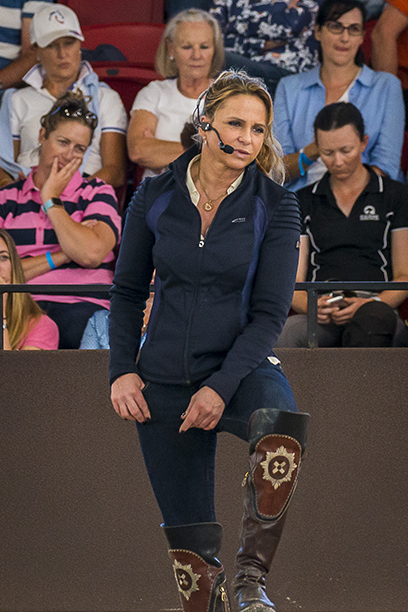
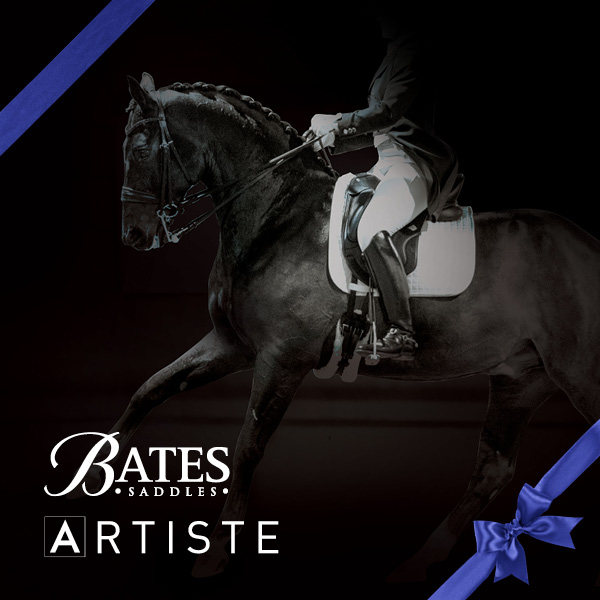
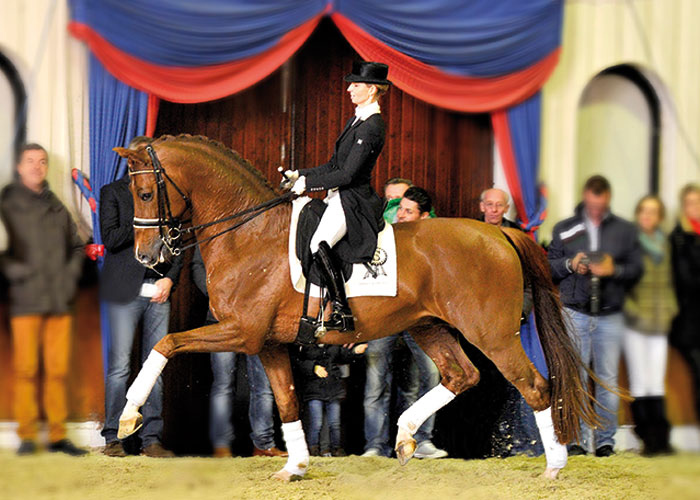
wow – great report Chris
can’t take the credit – Rebecca Ashton wrote the story and took the pix, and yes it was a great report/ CH